The Prediction of the Future Automobile Industry
VerifiedAdded on 2023/06/10
|6
|1552
|168
AI Summary
This article discusses the history of the automobile industry and predicts its future trends. It covers factors such as global economic performance, environmental policies, and political demand for automobile ammunitions. The article also emphasizes the need for innovation and integration of new technology to remain competitive in the market.
Contribute Materials
Your contribution can guide someone’s learning journey. Share your
documents today.
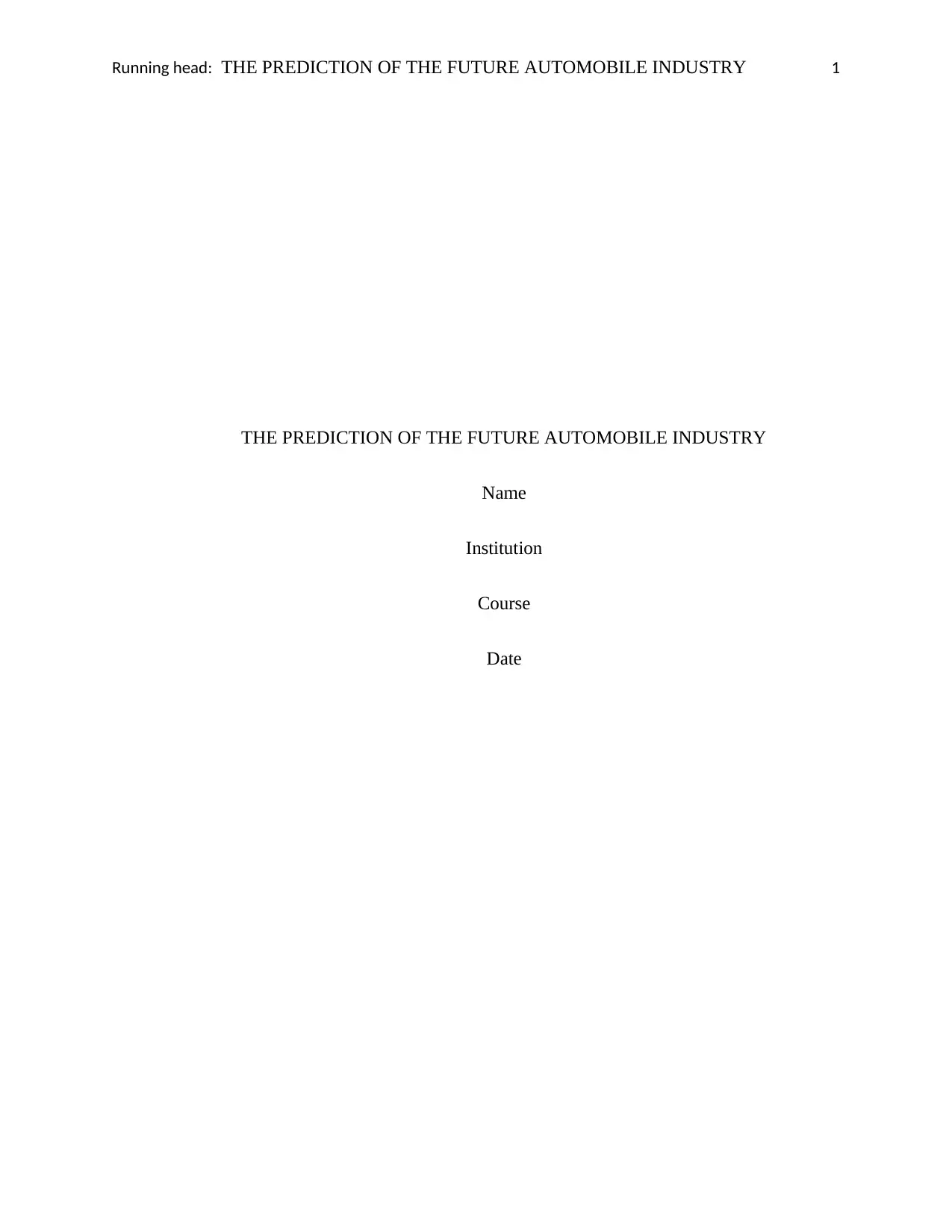
Running head: THE PREDICTION OF THE FUTURE AUTOMOBILE INDUSTRY 1
THE PREDICTION OF THE FUTURE AUTOMOBILE INDUSTRY
Name
Institution
Course
Date
THE PREDICTION OF THE FUTURE AUTOMOBILE INDUSTRY
Name
Institution
Course
Date
Secure Best Marks with AI Grader
Need help grading? Try our AI Grader for instant feedback on your assignments.
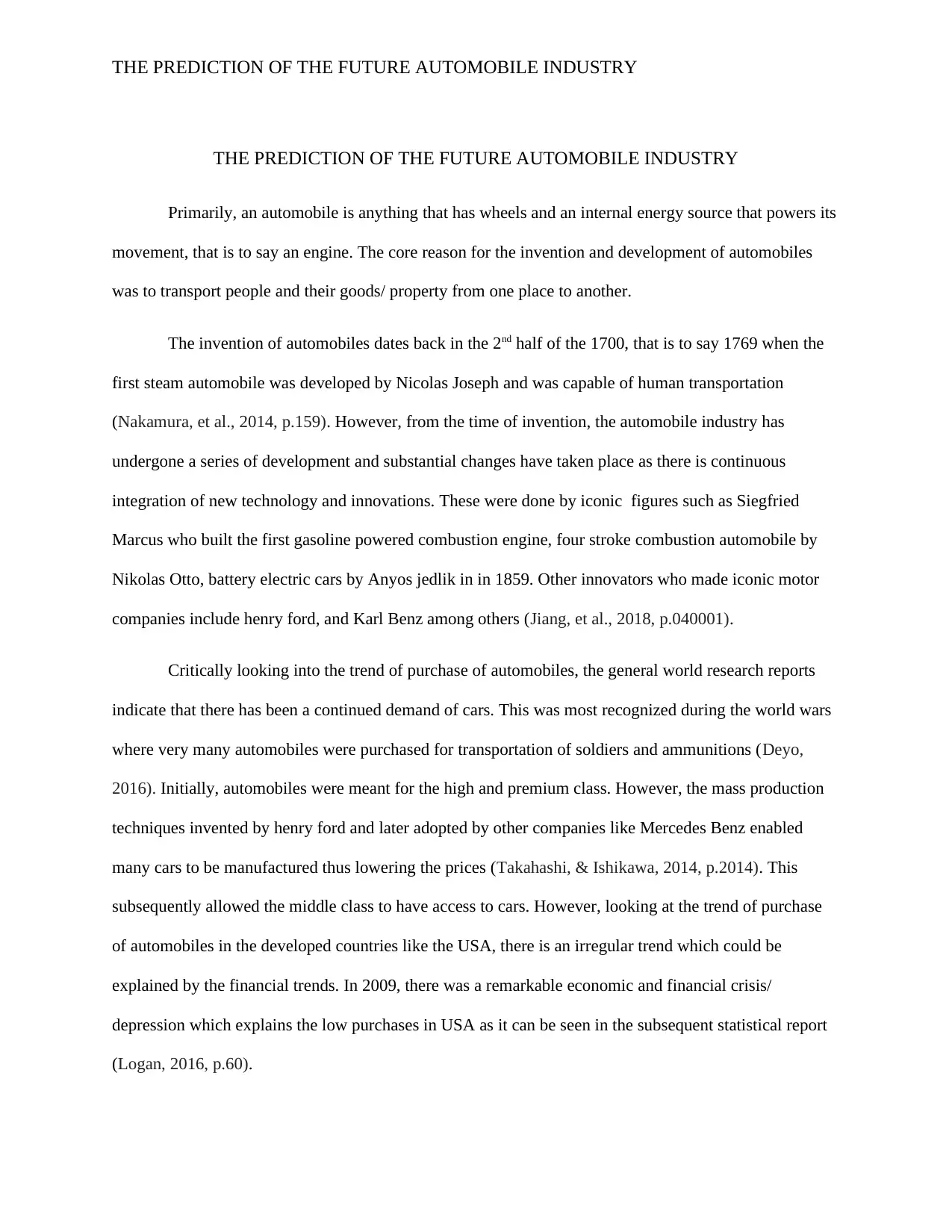
THE PREDICTION OF THE FUTURE AUTOMOBILE INDUSTRY
THE PREDICTION OF THE FUTURE AUTOMOBILE INDUSTRY
Primarily, an automobile is anything that has wheels and an internal energy source that powers its
movement, that is to say an engine. The core reason for the invention and development of automobiles
was to transport people and their goods/ property from one place to another.
The invention of automobiles dates back in the 2nd half of the 1700, that is to say 1769 when the
first steam automobile was developed by Nicolas Joseph and was capable of human transportation
(Nakamura, et al., 2014, p.159). However, from the time of invention, the automobile industry has
undergone a series of development and substantial changes have taken place as there is continuous
integration of new technology and innovations. These were done by iconic figures such as Siegfried
Marcus who built the first gasoline powered combustion engine, four stroke combustion automobile by
Nikolas Otto, battery electric cars by Anyos jedlik in in 1859. Other innovators who made iconic motor
companies include henry ford, and Karl Benz among others (Jiang, et al., 2018, p.040001).
Critically looking into the trend of purchase of automobiles, the general world research reports
indicate that there has been a continued demand of cars. This was most recognized during the world wars
where very many automobiles were purchased for transportation of soldiers and ammunitions (Deyo,
2016). Initially, automobiles were meant for the high and premium class. However, the mass production
techniques invented by henry ford and later adopted by other companies like Mercedes Benz enabled
many cars to be manufactured thus lowering the prices (Takahashi, & Ishikawa, 2014, p.2014). This
subsequently allowed the middle class to have access to cars. However, looking at the trend of purchase
of automobiles in the developed countries like the USA, there is an irregular trend which could be
explained by the financial trends. In 2009, there was a remarkable economic and financial crisis/
depression which explains the low purchases in USA as it can be seen in the subsequent statistical report
(Logan, 2016, p.60).
THE PREDICTION OF THE FUTURE AUTOMOBILE INDUSTRY
Primarily, an automobile is anything that has wheels and an internal energy source that powers its
movement, that is to say an engine. The core reason for the invention and development of automobiles
was to transport people and their goods/ property from one place to another.
The invention of automobiles dates back in the 2nd half of the 1700, that is to say 1769 when the
first steam automobile was developed by Nicolas Joseph and was capable of human transportation
(Nakamura, et al., 2014, p.159). However, from the time of invention, the automobile industry has
undergone a series of development and substantial changes have taken place as there is continuous
integration of new technology and innovations. These were done by iconic figures such as Siegfried
Marcus who built the first gasoline powered combustion engine, four stroke combustion automobile by
Nikolas Otto, battery electric cars by Anyos jedlik in in 1859. Other innovators who made iconic motor
companies include henry ford, and Karl Benz among others (Jiang, et al., 2018, p.040001).
Critically looking into the trend of purchase of automobiles, the general world research reports
indicate that there has been a continued demand of cars. This was most recognized during the world wars
where very many automobiles were purchased for transportation of soldiers and ammunitions (Deyo,
2016). Initially, automobiles were meant for the high and premium class. However, the mass production
techniques invented by henry ford and later adopted by other companies like Mercedes Benz enabled
many cars to be manufactured thus lowering the prices (Takahashi, & Ishikawa, 2014, p.2014). This
subsequently allowed the middle class to have access to cars. However, looking at the trend of purchase
of automobiles in the developed countries like the USA, there is an irregular trend which could be
explained by the financial trends. In 2009, there was a remarkable economic and financial crisis/
depression which explains the low purchases in USA as it can be seen in the subsequent statistical report
(Logan, 2016, p.60).
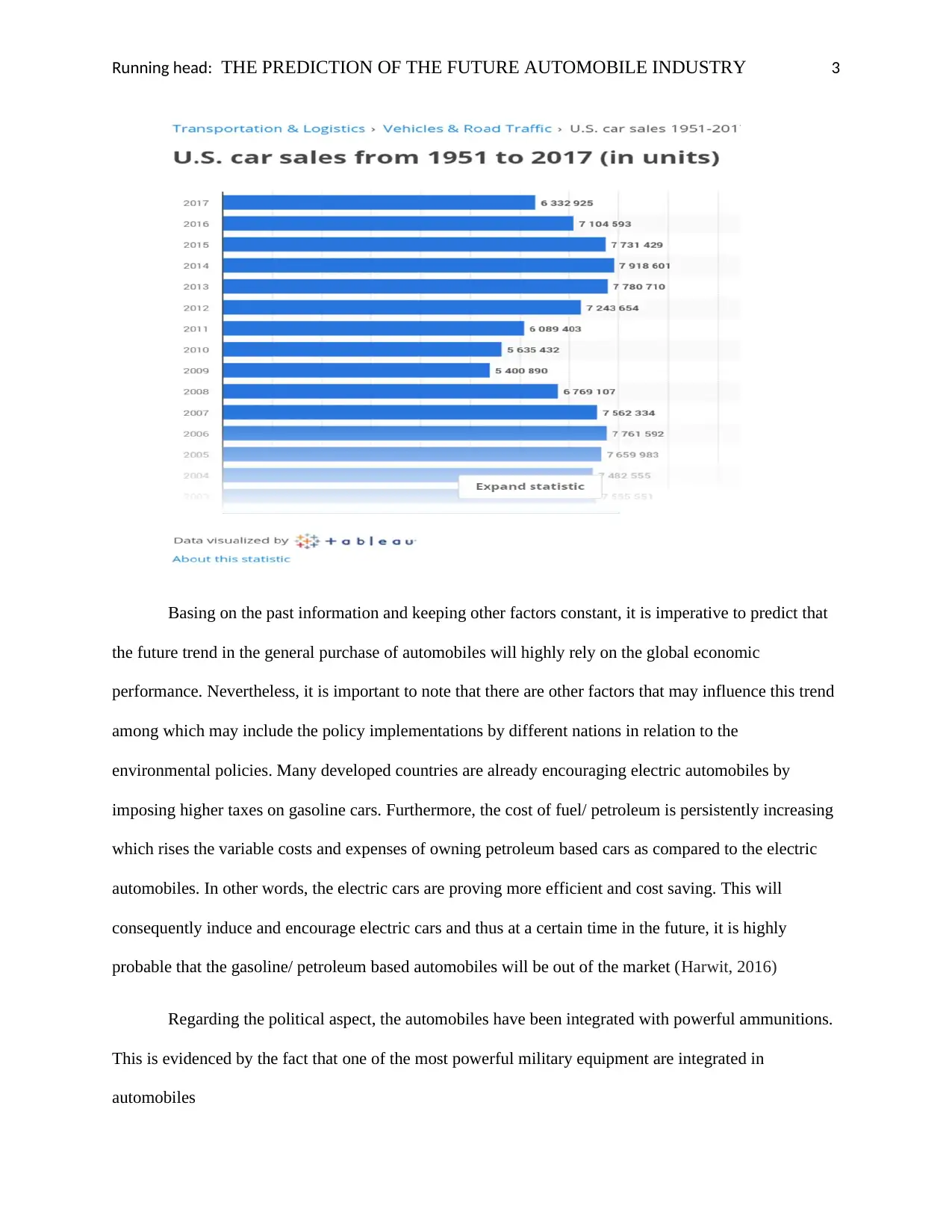
Running head: THE PREDICTION OF THE FUTURE AUTOMOBILE INDUSTRY 3
Basing on the past information and keeping other factors constant, it is imperative to predict that
the future trend in the general purchase of automobiles will highly rely on the global economic
performance. Nevertheless, it is important to note that there are other factors that may influence this trend
among which may include the policy implementations by different nations in relation to the
environmental policies. Many developed countries are already encouraging electric automobiles by
imposing higher taxes on gasoline cars. Furthermore, the cost of fuel/ petroleum is persistently increasing
which rises the variable costs and expenses of owning petroleum based cars as compared to the electric
automobiles. In other words, the electric cars are proving more efficient and cost saving. This will
consequently induce and encourage electric cars and thus at a certain time in the future, it is highly
probable that the gasoline/ petroleum based automobiles will be out of the market (Harwit, 2016)
Regarding the political aspect, the automobiles have been integrated with powerful ammunitions.
This is evidenced by the fact that one of the most powerful military equipment are integrated in
automobiles
Basing on the past information and keeping other factors constant, it is imperative to predict that
the future trend in the general purchase of automobiles will highly rely on the global economic
performance. Nevertheless, it is important to note that there are other factors that may influence this trend
among which may include the policy implementations by different nations in relation to the
environmental policies. Many developed countries are already encouraging electric automobiles by
imposing higher taxes on gasoline cars. Furthermore, the cost of fuel/ petroleum is persistently increasing
which rises the variable costs and expenses of owning petroleum based cars as compared to the electric
automobiles. In other words, the electric cars are proving more efficient and cost saving. This will
consequently induce and encourage electric cars and thus at a certain time in the future, it is highly
probable that the gasoline/ petroleum based automobiles will be out of the market (Harwit, 2016)
Regarding the political aspect, the automobiles have been integrated with powerful ammunitions.
This is evidenced by the fact that one of the most powerful military equipment are integrated in
automobiles
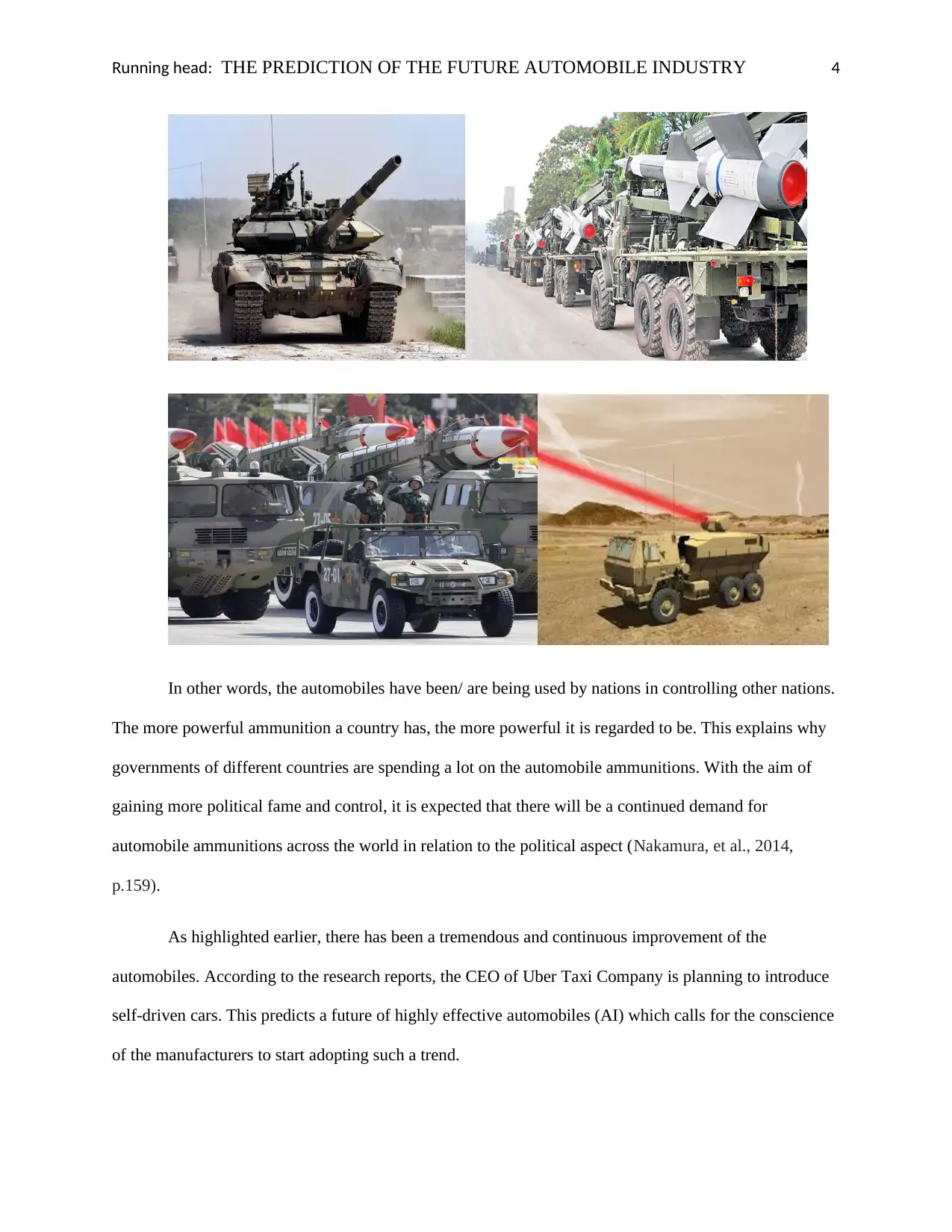
Running head: THE PREDICTION OF THE FUTURE AUTOMOBILE INDUSTRY 4
In other words, the automobiles have been/ are being used by nations in controlling other nations.
The more powerful ammunition a country has, the more powerful it is regarded to be. This explains why
governments of different countries are spending a lot on the automobile ammunitions. With the aim of
gaining more political fame and control, it is expected that there will be a continued demand for
automobile ammunitions across the world in relation to the political aspect (Nakamura, et al., 2014,
p.159).
As highlighted earlier, there has been a tremendous and continuous improvement of the
automobiles. According to the research reports, the CEO of Uber Taxi Company is planning to introduce
self-driven cars. This predicts a future of highly effective automobiles (AI) which calls for the conscience
of the manufacturers to start adopting such a trend.
In other words, the automobiles have been/ are being used by nations in controlling other nations.
The more powerful ammunition a country has, the more powerful it is regarded to be. This explains why
governments of different countries are spending a lot on the automobile ammunitions. With the aim of
gaining more political fame and control, it is expected that there will be a continued demand for
automobile ammunitions across the world in relation to the political aspect (Nakamura, et al., 2014,
p.159).
As highlighted earlier, there has been a tremendous and continuous improvement of the
automobiles. According to the research reports, the CEO of Uber Taxi Company is planning to introduce
self-driven cars. This predicts a future of highly effective automobiles (AI) which calls for the conscience
of the manufacturers to start adopting such a trend.
Secure Best Marks with AI Grader
Need help grading? Try our AI Grader for instant feedback on your assignments.
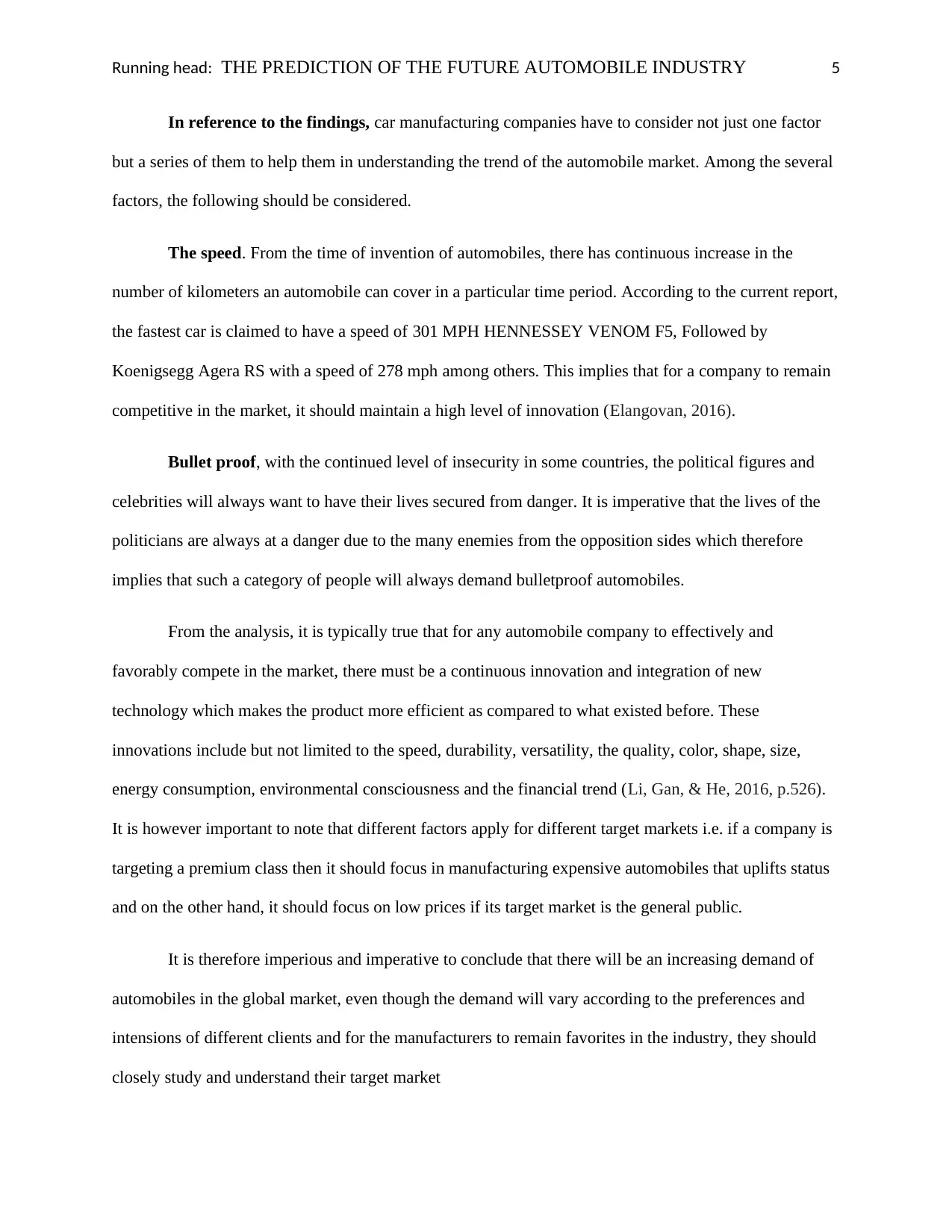
Running head: THE PREDICTION OF THE FUTURE AUTOMOBILE INDUSTRY 5
In reference to the findings, car manufacturing companies have to consider not just one factor
but a series of them to help them in understanding the trend of the automobile market. Among the several
factors, the following should be considered.
The speed. From the time of invention of automobiles, there has continuous increase in the
number of kilometers an automobile can cover in a particular time period. According to the current report,
the fastest car is claimed to have a speed of 301 MPH HENNESSEY VENOM F5, Followed by
Koenigsegg Agera RS with a speed of 278 mph among others. This implies that for a company to remain
competitive in the market, it should maintain a high level of innovation (Elangovan, 2016).
Bullet proof, with the continued level of insecurity in some countries, the political figures and
celebrities will always want to have their lives secured from danger. It is imperative that the lives of the
politicians are always at a danger due to the many enemies from the opposition sides which therefore
implies that such a category of people will always demand bulletproof automobiles.
From the analysis, it is typically true that for any automobile company to effectively and
favorably compete in the market, there must be a continuous innovation and integration of new
technology which makes the product more efficient as compared to what existed before. These
innovations include but not limited to the speed, durability, versatility, the quality, color, shape, size,
energy consumption, environmental consciousness and the financial trend (Li, Gan, & He, 2016, p.526).
It is however important to note that different factors apply for different target markets i.e. if a company is
targeting a premium class then it should focus in manufacturing expensive automobiles that uplifts status
and on the other hand, it should focus on low prices if its target market is the general public.
It is therefore imperious and imperative to conclude that there will be an increasing demand of
automobiles in the global market, even though the demand will vary according to the preferences and
intensions of different clients and for the manufacturers to remain favorites in the industry, they should
closely study and understand their target market
In reference to the findings, car manufacturing companies have to consider not just one factor
but a series of them to help them in understanding the trend of the automobile market. Among the several
factors, the following should be considered.
The speed. From the time of invention of automobiles, there has continuous increase in the
number of kilometers an automobile can cover in a particular time period. According to the current report,
the fastest car is claimed to have a speed of 301 MPH HENNESSEY VENOM F5, Followed by
Koenigsegg Agera RS with a speed of 278 mph among others. This implies that for a company to remain
competitive in the market, it should maintain a high level of innovation (Elangovan, 2016).
Bullet proof, with the continued level of insecurity in some countries, the political figures and
celebrities will always want to have their lives secured from danger. It is imperative that the lives of the
politicians are always at a danger due to the many enemies from the opposition sides which therefore
implies that such a category of people will always demand bulletproof automobiles.
From the analysis, it is typically true that for any automobile company to effectively and
favorably compete in the market, there must be a continuous innovation and integration of new
technology which makes the product more efficient as compared to what existed before. These
innovations include but not limited to the speed, durability, versatility, the quality, color, shape, size,
energy consumption, environmental consciousness and the financial trend (Li, Gan, & He, 2016, p.526).
It is however important to note that different factors apply for different target markets i.e. if a company is
targeting a premium class then it should focus in manufacturing expensive automobiles that uplifts status
and on the other hand, it should focus on low prices if its target market is the general public.
It is therefore imperious and imperative to conclude that there will be an increasing demand of
automobiles in the global market, even though the demand will vary according to the preferences and
intensions of different clients and for the manufacturers to remain favorites in the industry, they should
closely study and understand their target market
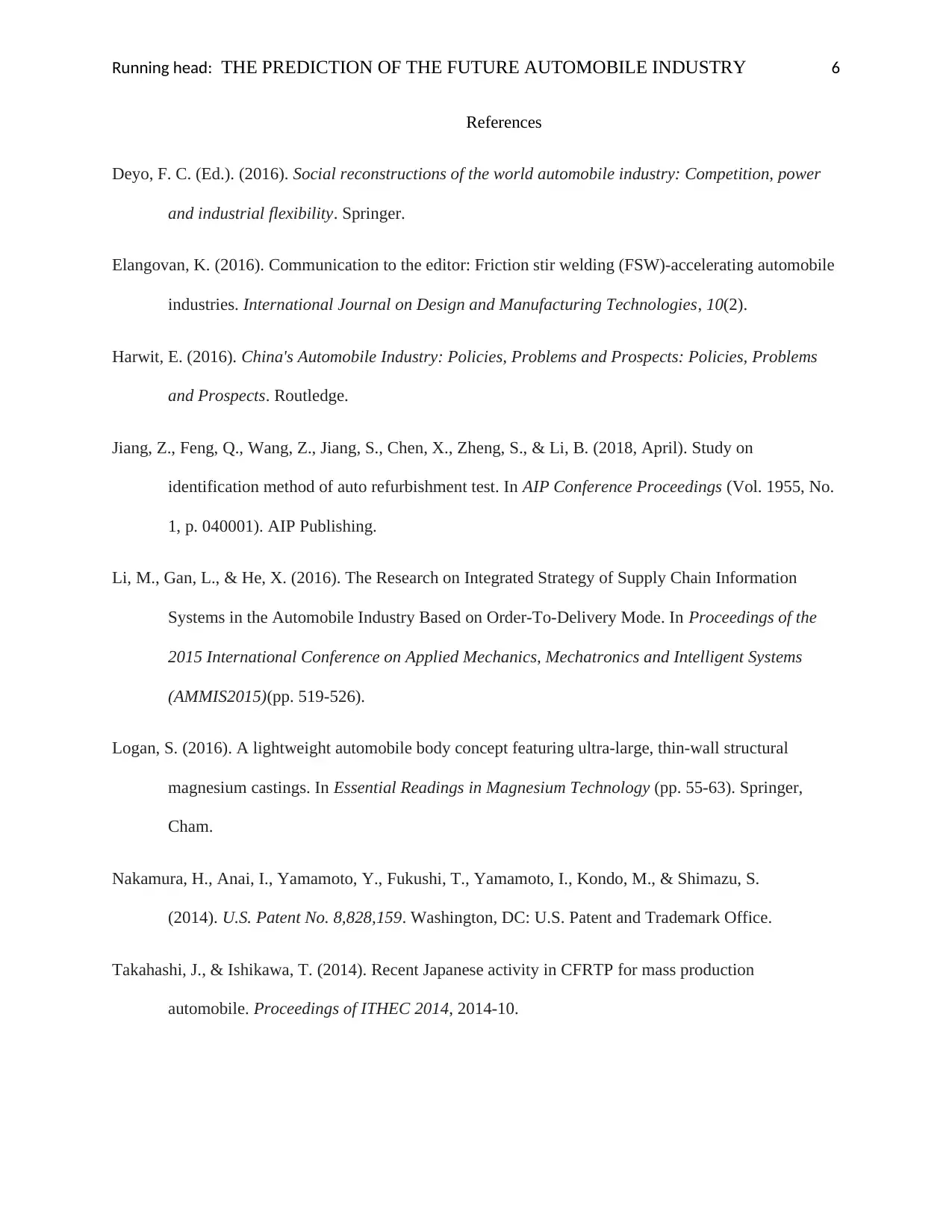
Running head: THE PREDICTION OF THE FUTURE AUTOMOBILE INDUSTRY 6
References
Deyo, F. C. (Ed.). (2016). Social reconstructions of the world automobile industry: Competition, power
and industrial flexibility. Springer.
Elangovan, K. (2016). Communication to the editor: Friction stir welding (FSW)-accelerating automobile
industries. International Journal on Design and Manufacturing Technologies, 10(2).
Harwit, E. (2016). China's Automobile Industry: Policies, Problems and Prospects: Policies, Problems
and Prospects. Routledge.
Jiang, Z., Feng, Q., Wang, Z., Jiang, S., Chen, X., Zheng, S., & Li, B. (2018, April). Study on
identification method of auto refurbishment test. In AIP Conference Proceedings (Vol. 1955, No.
1, p. 040001). AIP Publishing.
Li, M., Gan, L., & He, X. (2016). The Research on Integrated Strategy of Supply Chain Information
Systems in the Automobile Industry Based on Order-To-Delivery Mode. In Proceedings of the
2015 International Conference on Applied Mechanics, Mechatronics and Intelligent Systems
(AMMIS2015)(pp. 519-526).
Logan, S. (2016). A lightweight automobile body concept featuring ultra-large, thin-wall structural
magnesium castings. In Essential Readings in Magnesium Technology (pp. 55-63). Springer,
Cham.
Nakamura, H., Anai, I., Yamamoto, Y., Fukushi, T., Yamamoto, I., Kondo, M., & Shimazu, S.
(2014). U.S. Patent No. 8,828,159. Washington, DC: U.S. Patent and Trademark Office.
Takahashi, J., & Ishikawa, T. (2014). Recent Japanese activity in CFRTP for mass production
automobile. Proceedings of ITHEC 2014, 2014-10.
References
Deyo, F. C. (Ed.). (2016). Social reconstructions of the world automobile industry: Competition, power
and industrial flexibility. Springer.
Elangovan, K. (2016). Communication to the editor: Friction stir welding (FSW)-accelerating automobile
industries. International Journal on Design and Manufacturing Technologies, 10(2).
Harwit, E. (2016). China's Automobile Industry: Policies, Problems and Prospects: Policies, Problems
and Prospects. Routledge.
Jiang, Z., Feng, Q., Wang, Z., Jiang, S., Chen, X., Zheng, S., & Li, B. (2018, April). Study on
identification method of auto refurbishment test. In AIP Conference Proceedings (Vol. 1955, No.
1, p. 040001). AIP Publishing.
Li, M., Gan, L., & He, X. (2016). The Research on Integrated Strategy of Supply Chain Information
Systems in the Automobile Industry Based on Order-To-Delivery Mode. In Proceedings of the
2015 International Conference on Applied Mechanics, Mechatronics and Intelligent Systems
(AMMIS2015)(pp. 519-526).
Logan, S. (2016). A lightweight automobile body concept featuring ultra-large, thin-wall structural
magnesium castings. In Essential Readings in Magnesium Technology (pp. 55-63). Springer,
Cham.
Nakamura, H., Anai, I., Yamamoto, Y., Fukushi, T., Yamamoto, I., Kondo, M., & Shimazu, S.
(2014). U.S. Patent No. 8,828,159. Washington, DC: U.S. Patent and Trademark Office.
Takahashi, J., & Ishikawa, T. (2014). Recent Japanese activity in CFRTP for mass production
automobile. Proceedings of ITHEC 2014, 2014-10.
1 out of 6
Your All-in-One AI-Powered Toolkit for Academic Success.
+13062052269
info@desklib.com
Available 24*7 on WhatsApp / Email
![[object Object]](/_next/static/media/star-bottom.7253800d.svg)
Unlock your academic potential
© 2024 | Zucol Services PVT LTD | All rights reserved.
